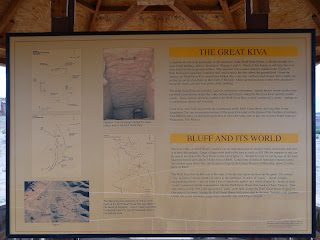Thursday, August 23, 2012
August 22: A Great House is a Great Place
Janet and I had planned to do some serious canyon exploration in the Bluff area, not only for rock art but for ancestral pueblo ruins. The archeological portion of our expedition was about to begin, although rock art sites now have been granted status as serious archeological sites in their own right.
However, weather forecasts called for thunderstorms and possible flash floods for Thursday and Friday. Oh well, we changed our plans.
In the morning, we went looking for archeological sites in Bluff itself. One prominent landmark was the "Navajo Twin Rocks."
These figure in Navajo mythology about the creation and the destruction of evil monsters who prevented human habitation of the earth surface.
In both Navajo and Pueblo mythologies, human beings were originally unformed primordial creatures living under the earth until they "emerged" on the earth's surface, thanks to the benefactions of animal and cosmic beings. We were "taught" to be human by the nonhuman "persons" who came before us and have superior power and knowledge (and morals!).
This is called the "emergence myth" and is fundamental for any understanding of Anasazi (ancestral Pueblo) architecture and art.
I suspected that there might be a site near the Twin Rocks and spotted a marked-off area that looked suspicious.
Later, at the Edge of Cedars Museum, I read a 2011 article by the museum's archeologist that discussed the discovery of a Pueblo I site at the foot of the Twin Rocks. Nice coincidence. The site has not been excavated.
Our main target was a half-mile away: the Bluff Great House.
I had read extensively about it before our trip. It is being researched by archeologists at the University of Colorado.
Not much to look at, I know, but that is not the point. Its masonry construction techniques are especially important.
The term "Great House" is actually a technical name for a large, two-story building that had very special social and ceremonial functions for Pueblo II and III cultures in the Four Corners area. It was not a home, but a place of high prestige and status to the clan that controlled it. Small village assemblies, like the one at the foot of Twin Rocks, clustered around it.
These Great Houses were uncommon and part of a regional system connected to Chaco Canyon, 150 miles to the south in New Mexico. Other Great Houses are on our itinerary. The Great Houses in Bluff and Blanding (Edge of Cedars) are two of the most northern examples that are known to archeologists.
Attached to the Bluff Great House was a Great Kiva, 45 feet in diameter, that served as a ceremonial center for villages up and down the canyons in this area.
The depression shows its location.
The combination of Great House and Great Kiva shows an increasing complexity of social organization and religious ritual. A faint road from the Great House leads in the direction of Chaco Canyon.
Chaco flourished between 1050 and 1150 A.D.
Chaco Canyon had a very elaborate religious ritual system, part of which relied on the Great House/Great Kiva system and part of which relied heavily on astronomical alignments. Such alignments undoubtedly were part of the ritual system and mythology of Chaco and its "outliers," like the Bluff Great House. Indeed, the Twin Rocks at Bluff are located due east of the center of the Great House.
I looked at my GPS for true east (not compass east) to verify this. Thus the sun rose between the two spires on the morning of the fall and spring equinoxes.
Furthermore, at the winter solstice, the sun rises directly over twin rocks miles away to the southeast.
These rocks mark an ancient plaza that has unusual characteristics, not found elsewhere in the region. It appears to be a dance plaza high on the bluffs across the San Juan.
The connection is intriguing, even though the dance plaza was not used at the time of the Great House occupation.
By the way, one way archeologists know about the ceremonial functions of "Great Houses" is that fancy, beautifully crafted bowls and vessels have been found in their rooms and huge trash sites (middens)--unlike the more ordinary, utilitarian pottery used for everyday purposes. Apparently, breaking the expensive pottery was often part of the conclusion of the ritual meals that must have been held there when visiting dignitaries from other villages were honored.
The best collection of ancient Pueblo pottery from the northern San Juan area is at the Edge of Cedars Museum in Blanding, Utah, 25 miles north of Bluff.
In the afternoon, we went to Edge of Cedars, one of my favorites--a small museum that thinks big.
Subscribe to:
Post Comments (Atom)











No comments:
Post a Comment